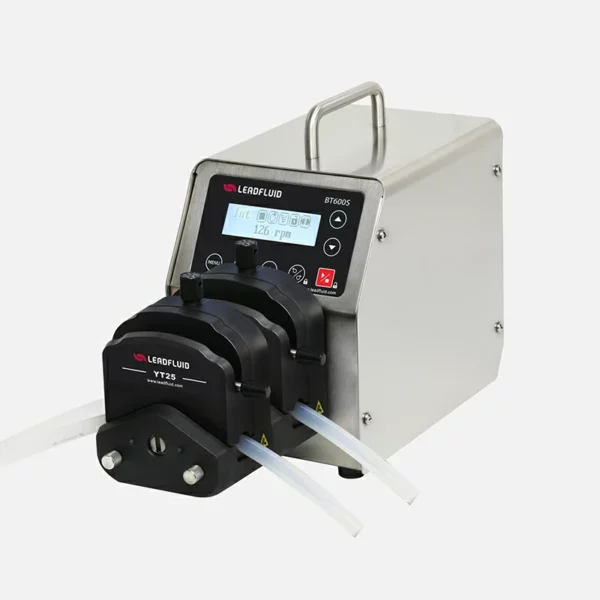A low flow peristaltic pump is a type of peristaltic pump specifically designed for applications that require precise and controlled flow rates at low volumes. These pumps are designed to accurately deliver small amounts of fluids, typically in the range of microliters to milliliters per minute. They are commonly used in laboratory settings, analytical instrumentation, medical devices, and other applications where precise dosing or fluid transfer is required.
Here are the key features and characteristics of low flow peristaltic pumps include:
- Flow Rate Control: Low flow peristaltic pumps offer precise control over the flow rate, allowing users to set and adjust the desired rate accurately. This is crucial in applications that require high precision and reproducibility.
- Small Tubing Sizes: Low flow peristaltic pumps typically use small-diameter tubing that can accommodate the low flow rates. The tubing sizes can vary but are often in the range of fractions of a millimeter, enabling accurate delivery of small volumes.
- Compact Size: Low flow peristaltic pumps are often compact and space-efficient, making them suitable for laboratory benchtops or integration into small-scale systems.
- Programmability and Automation: Many low flow peristaltic pumps offer programmability and automation features, allowing users to set specific dosing profiles, intervals, or sequences. This enables automated dosing processes and reduces the need for manual operation.
- Precise Dosing and Dispensing: Low flow peristaltic pumps excel in delivering precise and repeatable doses, making them ideal for applications such as drug delivery, microfluidics, chemical analysis, or sample preparation.
- Gentle Fluid Handling: Similar to other peristaltic pumps, low flow peristaltic pumps provide gentle fluid handling due to the squeezing action on the flexible tubing. This makes them suitable for handling sensitive fluids or samples that require minimal disturbance or shear.
- Easy Tubing Replacement: Low flow peristaltic pumps often have user-friendly designs that allow for quick and easy tubing replacement. This facilitates efficient maintenance, reduces downtime, and prevents cross-contamination between different fluids or samples.
- Compatibility with Various Fluids: Low flow peristaltic pumps can handle a wide range of fluids, including aqueous solutions, viscous fluids, corrosive substances, and even shear-sensitive samples. The choice of tubing material can be tailored to the specific fluid compatibility requirements.
Overall, low flow peristaltic pumps are designed to meet the demands of applications that require precise and controlled delivery of small volumes of fluids. Their accuracy, gentle fluid handling, and programmability make them valuable tools in laboratory research, medical diagnostics, and other industries where precise dosing or fluid transfer is crucial.
Where is the low flow peristaltic pump usually used ?
Low flow peristaltic pumps are commonly used in various industries and applications that require precise and controlled delivery of small volumes of fluids. Here are some specific areas where low flow peristaltic pumps find frequent use:
- Laboratory Research: Low flow peristaltic pumps are extensively used in scientific research laboratories, particularly in fields such as chemistry, biology, biochemistry, and pharmaceutical sciences. They are employed for precise dosing of reagents, solutions, and samples in experiments, assays, and analytical procedures.
- Analytical Instrumentation: Low flow peristaltic pumps are integrated into analytical instruments and systems that require accurate fluid delivery at low flow rates. They are utilized in applications such as liquid chromatography (LC), mass spectrometry (MS), spectroscopy, and other analytical techniques.
- Medical and Pharmaceutical Applications: Low flow peristaltic pumps are utilized in medical and pharmaceutical settings for drug delivery, microfluidics, and other applications. They are employed in research and development of drugs, clinical diagnostics, and medical devices such as infusion pumps or syringe pumps.
- Microfluidics: Low flow peristaltic pumps play a crucial role in microfluidic systems, which involve the manipulation and control of fluids at the microscale. They are used in lab-on-a-chip devices, microreactors, and other microfluidic platforms for precise fluid handling and control.
- Environmental Monitoring: Low flow peristaltic pumps are utilized in environmental monitoring projects, such as groundwater sampling, air sampling for pollutant analysis, or soil analysis. They enable controlled extraction of small volumes of samples for accurate testing and monitoring purposes.
- Food and Beverage Industry: Low flow peristaltic pumps find applications in the food and beverage industry for precise dispensing of flavorings, additives, colorants, or other ingredients. They are used in quality control processes, product development, and small-scale batch preparations.
- Biotechnology and Bioprocessing: Low flow peristaltic pumps are employed in biotechnology and bioprocessing applications, including cell culture, fermentation, and protein purification. They enable precise delivery of nutrients, media, and buffers, as well as controlled harvesting and separation of biomolecules.
- Research and Development: Low flow peristaltic pumps are utilized in various research and development settings, including academic research labs, industrial R&D facilities, or pilot plants. They find applications in process development, experimentation, and small-scale production.
These are some of the key areas where low flow peristaltic pumps are commonly used. Their ability to deliver precise flow rates at low volumes makes them valuable tools in applications that require accuracy, reproducibility, and gentle fluid handling.
